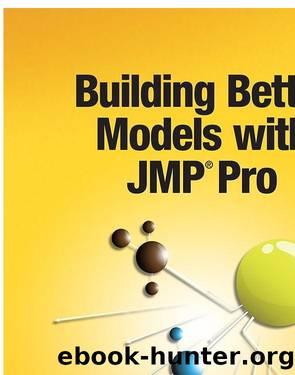Building Better Models with JMP Pro by Jim Grayson

Author:Jim Grayson
Language: eng
Format: epub
The fitted model has probabilities of Offer Accepted = Yes in the range
[0.0044, 0.6738]. Recall that when JMP classifies rows with the model, it uses a default of Prob > 0.5 to make the decision. In this case, only one of the predicted probabilities of Yes is > 0.5, and this one node has only 11
observations: 8 yes and 3 no under Response Counts in the bottom table in
Figure 6.29. The next highest predicted probability of Offer Accepted = Yes is 0.2056. As a result, all other rows are classified as Offer Accepted = No.
The ROC Curve
Two additional measures of accuracy used when building classification models are Sensitivity and (1-Specificity). Sensitivity is the true positive rate. In our example, this is the ability of our model to correctly classify Offer Accepted as Yes. The second measure, (1-Specificity), is the false positive rate. In this case, a false positive occurs when an offer was not accepted, but was classified as Yes (accepted).
Instead of using the default decision rule of Prob > 0.5, we examine the decision rule Prob > T, where we let the decision threshold T range from 0 to 1. We plot the Sensitivity (on the y-axis) versus the (1-Specificity) (on the x-
axis) for each possible threshold value. This creates a Receiver Operating Characteristic ( ROC) curve. The ROC curve can be displayed by selecting that option from the top red triangle in the Partition report.
Figure 6.30: Credit, ROC Curve for Offer Accepted
Download
This site does not store any files on its server. We only index and link to content provided by other sites. Please contact the content providers to delete copyright contents if any and email us, we'll remove relevant links or contents immediately.
| Biomathematics | Differential Equations |
| Game Theory | Graph Theory |
| Linear Programming | Probability & Statistics |
| Statistics | Stochastic Modeling |
| Vector Analysis |
Weapons of Math Destruction by Cathy O'Neil(5037)
Factfulness: Ten Reasons We're Wrong About the World – and Why Things Are Better Than You Think by Hans Rosling(4022)
Factfulness_Ten Reasons We're Wrong About the World_and Why Things Are Better Than You Think by Hans Rosling(2754)
Descartes' Error by Antonio Damasio(2732)
A Mind For Numbers: How to Excel at Math and Science (Even If You Flunked Algebra) by Barbara Oakley(2691)
TCP IP by Todd Lammle(2640)
Applied Predictive Modeling by Max Kuhn & Kjell Johnson(2479)
Fooled by Randomness: The Hidden Role of Chance in Life and in the Markets by Nassim Nicholas Taleb(2413)
The Book of Numbers by Peter Bentley(2404)
The Tyranny of Metrics by Jerry Z. Muller(2401)
The Great Unknown by Marcus du Sautoy(2186)
Once Upon an Algorithm by Martin Erwig(2149)
Easy Algebra Step-by-Step by Sandra Luna McCune(2117)
Practical Guide To Principal Component Methods in R (Multivariate Analysis Book 2) by Alboukadel Kassambara(2093)
Lady Luck by Kristen Ashley(2073)
Police Exams Prep 2018-2019 by Kaplan Test Prep(2033)
Linear Time-Invariant Systems, Behaviors and Modules by Ulrich Oberst & Martin Scheicher & Ingrid Scheicher(1983)
All Things Reconsidered by Bill Thompson III(1960)
Secrets of Creation, Volume 1: The Mystery of the Prime Numbers by Watkins Matthew(1864)
